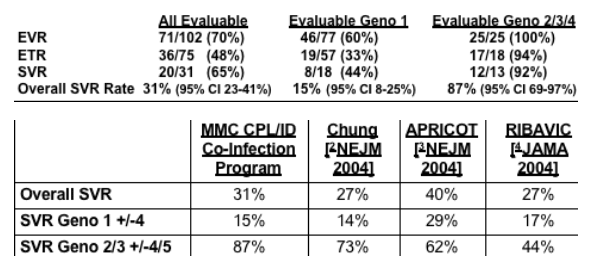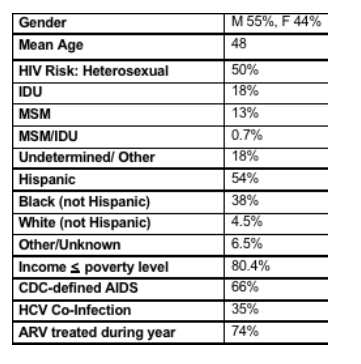 |
 |
 |
| |
NY Montefiore Hospital Coinfection Program Reports Success With a Multi-Disciplinary Program: Model of Care
|
| |
| |
Reported by Jules Levin
DDW, May 2007-05-31
NOTE FROM JULES: This program at Montefiore Hospital, a major hospital situated in the Bronx is at the core of an area where injection drug use and HIV are probably among the highest rates in the USA in any major city in the USA. The program receives funded from the Ryan White Care Act and NY State AIDS Institute. The multi-disciplinary approach utilized is the core underpinning for the program's success. This program is a great example of the type of model program needed to be commonly implemted where HCV coinfection is prevalent. A predecessor model program was alsostarted in NYC at the Brooklyn Hospital PATH Center. Hepatitis C language was inserted in the newly re-approved Ryan White Care Act due to a 4 year effort by NATAP and supporters. This language should be used by major city HIV clinic-based hospitals to fund coinfection programs utilizing the same multi-disciplinary approach. When I embarked on the 4 year oddyssey I hoped the language would be used to provide financial support for clinic-based programs like this. But also to establish and support HCV & HBV education at AIDS service organizations and linkage programs between ASOs and clinics. The newly reauthorized Ryan White Care Act was approved in Dec 2006, but as yet it does not appear to me that HRSA, local Ryan White Councils, nor the States have made any changes. It does not even appear to me that they know yet about the new changes and how to use them to establish important programs. HRSA does however know about the new language in the Care Act, but they are such an effective and uselessly large bureacracy that they have not & I suspect will not do anything. Clinicians remain undereducated about coinfection and patients and service providers are undereducated. This will change I believe when we have a therapy regimen that contains an oral agent, like VX-950 (the HCV protease inhibitor furthest along in development), which is expected to become available within 3 years, if there are no hitches. There are so many oral drugs in earlier stages of development that I expect us to eventually reach a cure rate of 70-90% including in Blacks & genotype 1. Eventually we will have regimens that contain 2-4 oral drugs with or without peginterferon and ribavirin. Numerous drug companies have oral agent development programs including Roche, GSK, Abbott, Pfizer, Novartis, Gilead, and BMS. The idea behind the HCV & HBV language in the Care Act was to provide support and funding to set up an care infrastructure for coinfected patients for the difficult present and the promising future.
"Outcomes in a Multidisciplinary HIV/Hepatitis C Co-Infection Program: Validation of a Model of Care and Comparison with Major Clinical Trials"
Barry S. Zingman1,2,3*, Hilda Morales1, Frances Rodriguez1, Katherine Freeman1,2,3, Tom Portzline1,2, Rosalynn Cruz1, William Goeren1, Leticia Aliaga1, Ricardo Yanes1, Jonathan Shuter1,2.
1Montefiore Medical Center (MMC) and 2Albert Einstein College of Medicine, Bronx, NY; 3Einstein/MMC Center for AIDS Research, Bronx, NY.
ABSTRACT
Background: A multidisciplinary HIV/Hepatitis C (HCV) Co-Infection Program was established in 2003 at the MMC AIDS Center's Center for Positive Living/ID Clinic, an inner city clinic serving a largely poor and minority HIV+ population with about 38% HCV co-infection. Staff include a medical director, NP, patient educators, psychiatrist, substance use counselor, nutritionist, social worker, and statistician. Validation of this treatment model is needed, including demonstration of outcomes in comparison to major clinical trials of HCV treatment in co-infection.
Methods: Prospective evaluation. Standard treatment durations and dosing of pegylated interferon/ribavirin by HCV genotype (geno) were used. All treated patients are included including those retreated for failure. EVR= >1 log drop in HCV RNA at 12 wks; ETR= undetectable HCV RNA at completion of planned treatment; SVR=undetectable HCV RNA >6 months after ETR. All analyses are ITT with censoring of: those on treatment <12 weeks could not be designated as EVR; EVRs who moved are unevaluable for ETR; ETRs who moved or are <6 months after ETR ("pending") are unevaluable for SVR. Overall SVR Rates = %ETR x %SVR.
Results:
Treatment Outcomes as of 9/30/06
- 116 treatment courses in 114 Patients
- (6 courses to those with previous failure - all Genotype 1)
- 74% male, 74% Hispanic, 75% HCV geno 1
- Mean CD4 count by HCV Genotype (p=NS): Geno 1- 447; 2/3 - 357; 4 - 553
- 38 treatments in progress (13 under <12 wks treatment)
- Did not complete treatment: 4 due to side effects; 7 moved, non-adherent, incarcerated, pt choice, or lost to follow-up
Overall ITT SVR Rate: 31% (20/31); genotype 1, 15% (8/18); geno 2/3: 92% (12/13); 87% geno 2/3). Results in evaluable patients are better; all evaluable: 20/31, 65% SVR; evaluable geno 1: 8/18, 44%; evaluable geno 2/3/4: 12/13, 92%.

The Overall SVR Rates of the Program compare favorably to a 27% SVR rate (14% geno 1, 73% other genos) in Chung NEJM 2004; a 40% SVR rate (29% geno 1, 62% genos 2/3) in Torriani [APRICOT] NEJM 2004; and a 27% SVR rate (17% genos 1/4, 44% genos 2/3/5) in Carrat [RIBAVIC] JAMA 2004.
Conclusions: The Montefiore HIV/HCV Co-Infection Program's multidisciplinary approach demonstrates outcomes comparable to major U.S. and international studies of HCV treatment in co-infected patients. The Program's results are especially notable given its inner-city population and inclusion of some with previous treatment failure. The data suggest that this model, if widely replicated, could improve HCV treatment outcomes among co-infected patients.
BACKGROUND & REFERENCES
HIV/HCV: major cause of morbidity and mortality in U.S.1 - accelerated progression, complicates HIV treatment
All co-infected are candidates for treatment:
Pegylated interferon plus ribavirin efficacious in major trials of co-infected patients2-4
Treatment barriers: immune suppression, rapid progression, HCV knowledge, substance use, psychiatric co-morbidity, access to expert care, adherence, side effect rates, treatment response rates1,5
Typically, <10% of co-infected are treated for HCV6-7, with far lower success rates than mono-infected
Experienced centers have multidisciplinary teams for HCV in non-HIV-infected including drug users8-10
This approach particularly needed in HIV/HCV co-infected; could result in major improvements in outcomes
Validation of results and comparison to optimized outcomes in clinical trials is needed
1Soriano AIDS 2004;18:1; 2Chung N Engl J Med 2004:351:451; 3Torriani NEJM 2004:351:438; 4Carrat JAMA 2004:292:2839; 5Braitstein AIDS 2004;18:2221; 6Fleming Clin Infect Dis 2003;36:97; 7Manfredi J AIDS 2005;38:238; 8Litwin Clin Infect Dis 2005;40:S339; 9Fleming Clin Infect Dis 2005;40:S349; 10Taylor Clin Infect Dis 2005;40:S355
HYPOTHESIS & METHODS
1. Hypotheses:
A multidisciplinary, expert, HIV/HCV co-infection team at an HIV primary care clinic, addressing needs at all stages, would improve outcomes:
-- HIV-related parameters, psychiatric and substance use co-morbidity, education about HIV and HCV infections, treatment of cirrhosis
A multidisciplinary expert HIV/HCV co-infection team at an HIV primary care clinic would increase:
-- Rates of pre-treatment HCV evaluation, initiation of HCV treatment, successful HCV treatment outcomes, chance of outcomes in a "real world" setting equal to those of major clinical trials
2. Funding: HRSA Ryan White Program and NYS DOH AIDS Institute since 10/03; Einstein/MMC CFAR
3. HIV/HCV Co-Infection Program:
Medical Director, Nurse Practitioner, Patient Educator/Adherence Counselor, Psychiatrist, Nurse, Substance Use Counselor, Nutritionist, Hepatologist, Biostatistician; a Social Worker assists referrals from other Montefiore sites
-- Pegylated interferon preferentially given weekly in clinic by the NP or Nurse
4. Data Collection/Outcomes Evaluation:
Prospective evaluation; standardized data collection at every visit
--Assessed for outcomes (EVR, ETR, SVR, Failure) and staged as Preparatory (PREP), Pre-Treatment Evaluation (Pre-RxEval), Treatment (Rx), Post-Treatment (Post-Rx), or Cirrhosis (CIRRH)
-- Demographics from Uniform Reporting System (URS) software; lab data from Montefiore clinical information system; data as of 9/30/06 (36 months into program) analyzed using SAS v. 9.1.2.; Overall SVR Rates for Program calculated by %ETR x %SVR.
RESULTS
CPL/ID Clinic 2006 Demographics: 2425 HIV Primary Care Patients
55% men. Mean age: 48.
HIV risk: heterosexual, 50%
IDU: 18%
13% MSM
msm/IDU: 0.7%
Hispanic: 54%
Black: 38%
White: 4.5%
Undetermined/other: 18%
Income < poverty level: 80.4%
CDC Decfined AIDS: 66%
HCV coinfection: 35%
ARV treated during year; 74%

36 Month Overall Co-Infection Program Demographics and other Characteristics
406 patients seen; mean age 47.7
65% male; 69.8% Hispanic; 29.1% Black

HCV Genotype:
1 - 85.5%; 2 - 6.8%; 3 - 5.9%; 4 - 1.8%
Entry Visit: 54% Pre-RxEval, 33% PREP
Visits: NP 4110 (56.0%), Pt Educator 1286 (17.5%), Psych 912 (12.4%), Substance Abuse 563 (7.7%), Dietician 242 (3.3%), GI 110 (1.5%), Social Worker 121 (1.7%)
Liver biopsies: 92
NOTE FROM AUTHOR Barry Zingman, MD: Entry Visit data: We stage every patient at every visit as either: "Preparatory", "Pre-Treatment Evaluation", "Treatment", "Post-Treatment", or "Cirrhotic". Preparatory are is our way of optimistically classifying those patients who are currently far from being ready to start the evaluations to prepare them for treatment, for one of many reasons such as low CD4, active mental health issues or heavy drug use, low CD4, inadequate education or interest, pattern of nonadherence to care, etc, but in whom we identify the barriers present and begin working with them on them towards treatment readiness. Pre-treatent eval means they are accepting of and begin one or more of: real education toward treatment, staging, psychiatric preparation, bloods, liver biopsy, etc. The Entry Visit data is their stage at the first visit into the program: 54% of patients were staged as being at the "Pre-Treatment Evaluation" stage, 33% of patients were at the "Preparatory" stage. The remainder entered the program at the other stages, but these two are the main two categories.
Visits: This is the number of program visits by each team member and the percentage of the total visits by that person. We added an RN just as the data for this abstract was being cut off. Now the NP and RN share many of the Treatment stage visits.
AUTHOR CONCLUSIONS
The Montefiore Center for Positive Living/I.D. Clinic HIV/HCV Co-Infection Program demonstrates outcomes equivalent to major U.S. and international clinical trials.
The Program's results are especially notable given its inner-city population and inclusion of some with previous treatment failure.
The data suggest that this model, if widely replicated, could improve HCV treatment outcomes among co-infected patients and result in large numbers of patients being evaluated and treated for HCV.
The critical importance of targeting Genotype 2/3/4 patients for treatment is clear from the high SVR rate in this group.
There is an urgent need to develop better therapies and approaches for Genotype 1 patients, e.g.:
--Longer treatment if lack of rapid virologic response
-- Weight-based ribavirin dosing
--New interferons/other agents/regimens
--Managing insulin resistance/fatty liver
|
| |
|
 |
 |
|
|